Case Study: Risk Management Strategies at Wal-Mart Stores
VerifiedAdded on 2023/04/22
|14
|3222
|108
Case Study
AI Summary
This case study provides an analysis of Wal-Mart's risk management strategies, focusing on compliance with legislation and regulations, operational risks, and innovative approaches to risk mitigation. It addresses key aspects such as adherence to Fair Work Act 2009, Competition & Consumer Act 2010, and Australian Consumer Law, among others. The study highlights the importance of understanding and managing both internal and external risks, including supply chain vulnerabilities and potential financial irregularities. Wal-Mart's implementation of Axonify for worker safety, blockchain technology for food traceability, and data analytics for accident reduction are discussed as proactive measures. The case study further outlines a five-stage risk management process, from risk revelation to shareholder value assessment, emphasizing the continuous improvement and adaptation necessary for maintaining a competitive edge in the retail sector. The document emphasizes the importance of risk management in improving execution, fostering innovation, and supporting the achievement of organizational objectives, with a focus on creating a risk management culture where employees are aware of the importance of monitoring and managing hazards.
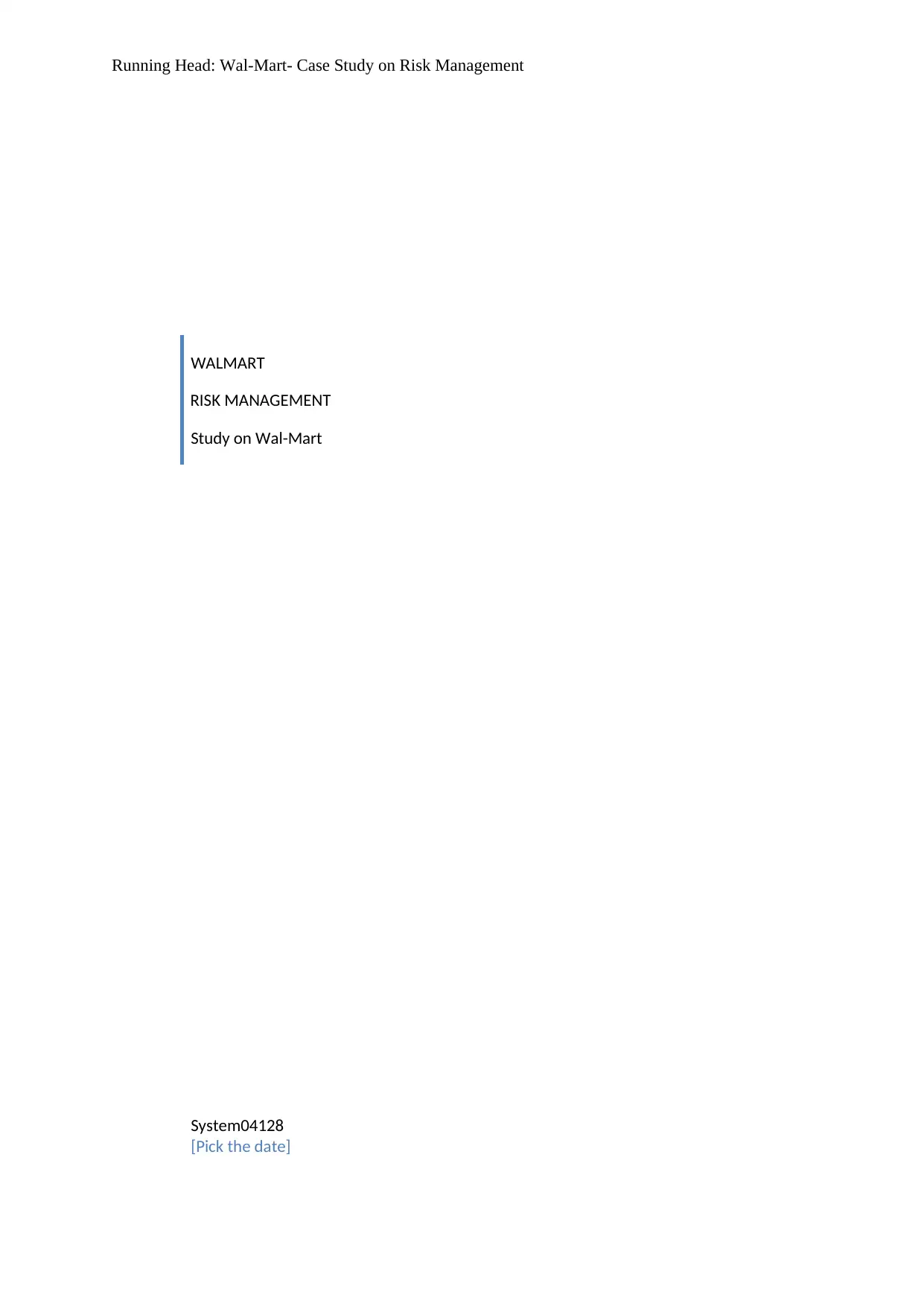
Running Head: Wal-Mart- Case Study on Risk Management
WALMART
RISK MANAGEMENT
Study on Wal-Mart
System04128
[Pick the date]
WALMART
RISK MANAGEMENT
Study on Wal-Mart
System04128
[Pick the date]
Paraphrase This Document
Need a fresh take? Get an instant paraphrase of this document with our AI Paraphraser
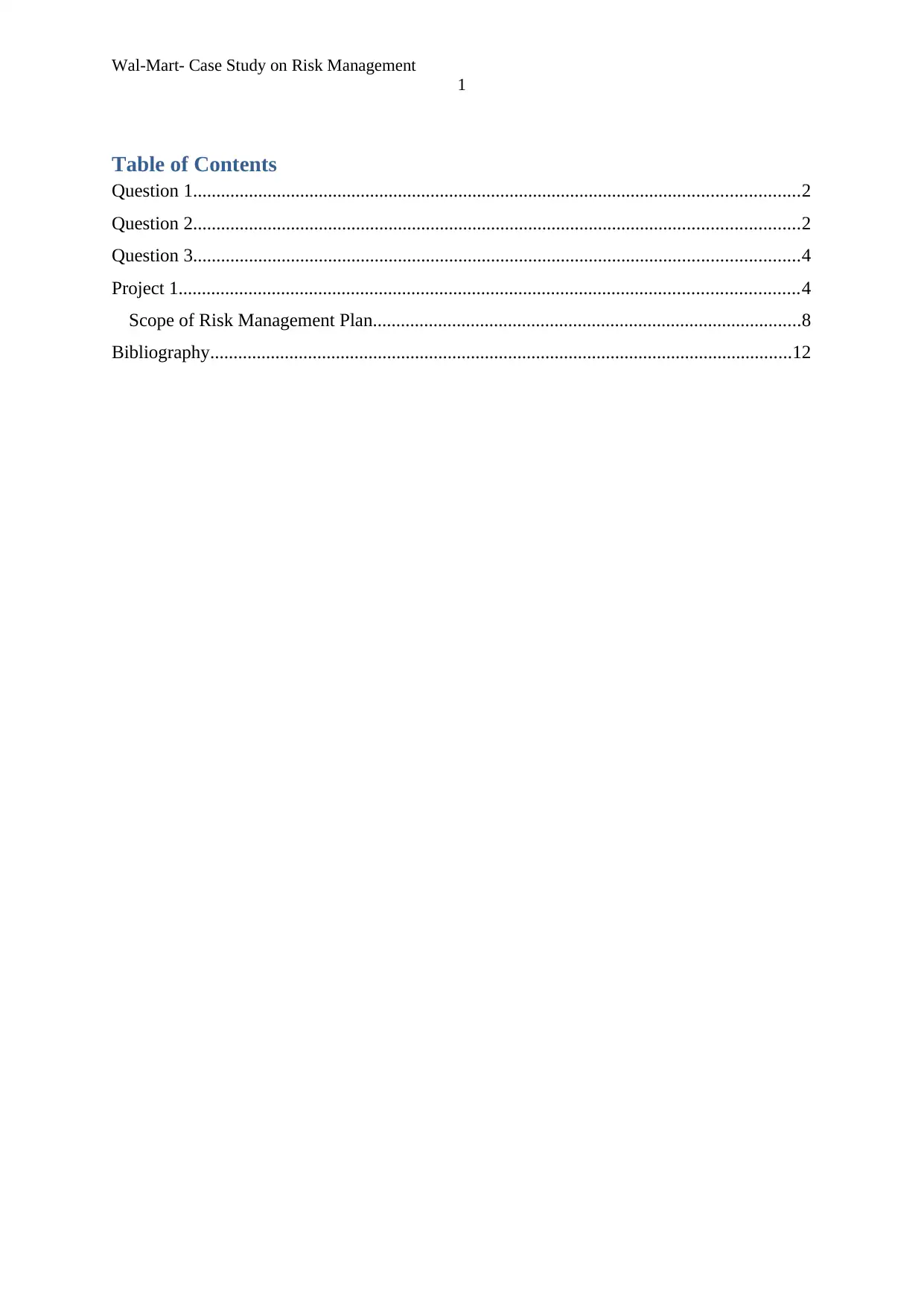
Wal-Mart- Case Study on Risk Management
1
Table of Contents
Question 1..................................................................................................................................2
Question 2..................................................................................................................................2
Question 3..................................................................................................................................4
Project 1.....................................................................................................................................4
Scope of Risk Management Plan............................................................................................8
Bibliography.............................................................................................................................12
1
Table of Contents
Question 1..................................................................................................................................2
Question 2..................................................................................................................................2
Question 3..................................................................................................................................4
Project 1.....................................................................................................................................4
Scope of Risk Management Plan............................................................................................8
Bibliography.............................................................................................................................12
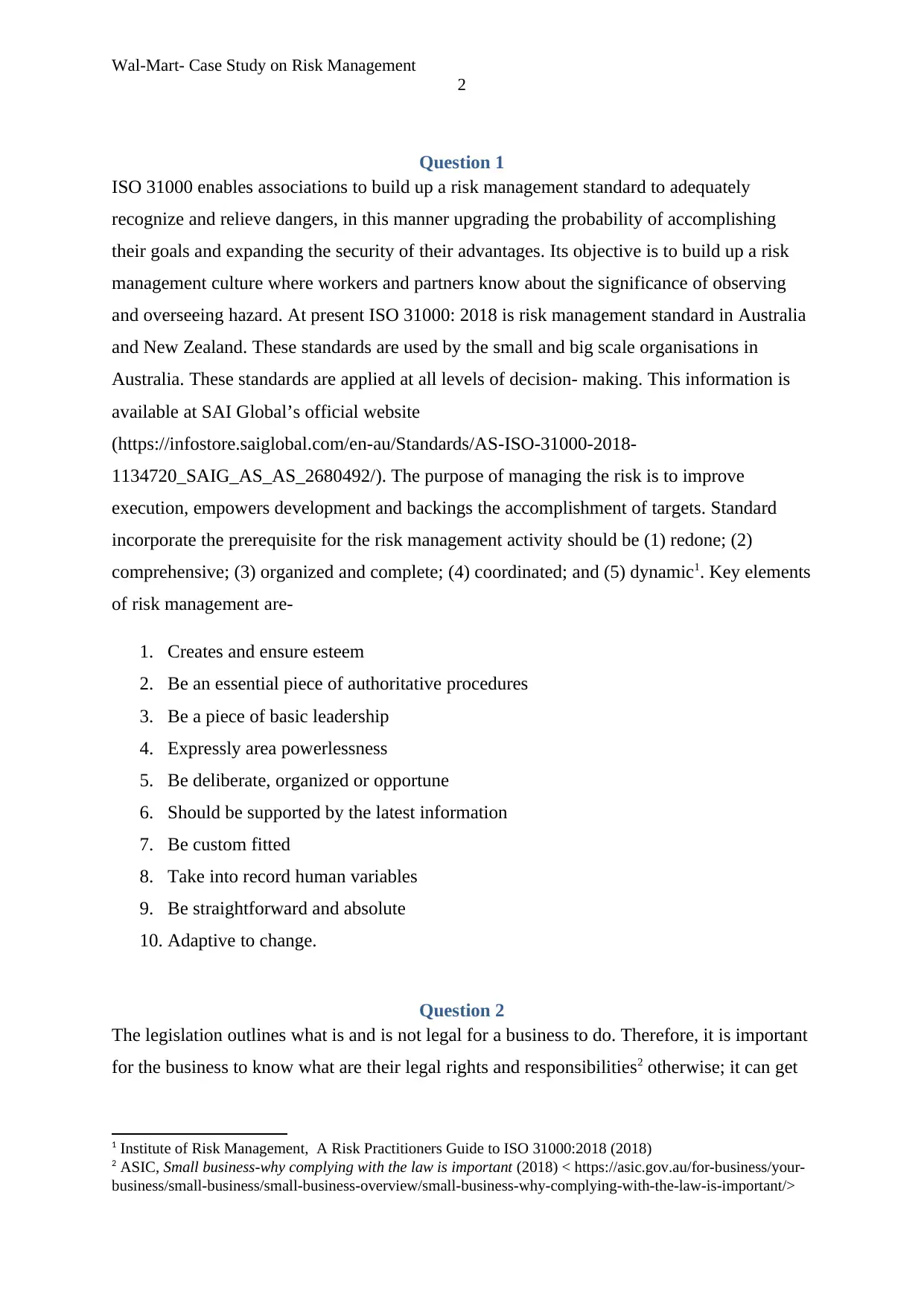
Wal-Mart- Case Study on Risk Management
2
Question 1
ISO 31000 enables associations to build up a risk management standard to adequately
recognize and relieve dangers, in this manner upgrading the probability of accomplishing
their goals and expanding the security of their advantages. Its objective is to build up a risk
management culture where workers and partners know about the significance of observing
and overseeing hazard. At present ISO 31000: 2018 is risk management standard in Australia
and New Zealand. These standards are used by the small and big scale organisations in
Australia. These standards are applied at all levels of decision- making. This information is
available at SAI Global’s official website
(https://infostore.saiglobal.com/en-au/Standards/AS-ISO-31000-2018-
1134720_SAIG_AS_AS_2680492/). The purpose of managing the risk is to improve
execution, empowers development and backings the accomplishment of targets. Standard
incorporate the prerequisite for the risk management activity should be (1) redone; (2)
comprehensive; (3) organized and complete; (4) coordinated; and (5) dynamic1. Key elements
of risk management are-
1. Creates and ensure esteem
2. Be an essential piece of authoritative procedures
3. Be a piece of basic leadership
4. Expressly area powerlessness
5. Be deliberate, organized or opportune
6. Should be supported by the latest information
7. Be custom fitted
8. Take into record human variables
9. Be straightforward and absolute
10. Adaptive to change.
Question 2
The legislation outlines what is and is not legal for a business to do. Therefore, it is important
for the business to know what are their legal rights and responsibilities2 otherwise; it can get
1 Institute of Risk Management, A Risk Practitioners Guide to ISO 31000:2018 (2018)
2 ASIC, Small business-why complying with the law is important (2018) < https://asic.gov.au/for-business/your-
business/small-business/small-business-overview/small-business-why-complying-with-the-law-is-important/>
2
Question 1
ISO 31000 enables associations to build up a risk management standard to adequately
recognize and relieve dangers, in this manner upgrading the probability of accomplishing
their goals and expanding the security of their advantages. Its objective is to build up a risk
management culture where workers and partners know about the significance of observing
and overseeing hazard. At present ISO 31000: 2018 is risk management standard in Australia
and New Zealand. These standards are used by the small and big scale organisations in
Australia. These standards are applied at all levels of decision- making. This information is
available at SAI Global’s official website
(https://infostore.saiglobal.com/en-au/Standards/AS-ISO-31000-2018-
1134720_SAIG_AS_AS_2680492/). The purpose of managing the risk is to improve
execution, empowers development and backings the accomplishment of targets. Standard
incorporate the prerequisite for the risk management activity should be (1) redone; (2)
comprehensive; (3) organized and complete; (4) coordinated; and (5) dynamic1. Key elements
of risk management are-
1. Creates and ensure esteem
2. Be an essential piece of authoritative procedures
3. Be a piece of basic leadership
4. Expressly area powerlessness
5. Be deliberate, organized or opportune
6. Should be supported by the latest information
7. Be custom fitted
8. Take into record human variables
9. Be straightforward and absolute
10. Adaptive to change.
Question 2
The legislation outlines what is and is not legal for a business to do. Therefore, it is important
for the business to know what are their legal rights and responsibilities2 otherwise; it can get
1 Institute of Risk Management, A Risk Practitioners Guide to ISO 31000:2018 (2018)
2 ASIC, Small business-why complying with the law is important (2018) < https://asic.gov.au/for-business/your-
business/small-business/small-business-overview/small-business-why-complying-with-the-law-is-important/>
⊘ This is a preview!⊘
Do you want full access?
Subscribe today to unlock all pages.

Trusted by 1+ million students worldwide
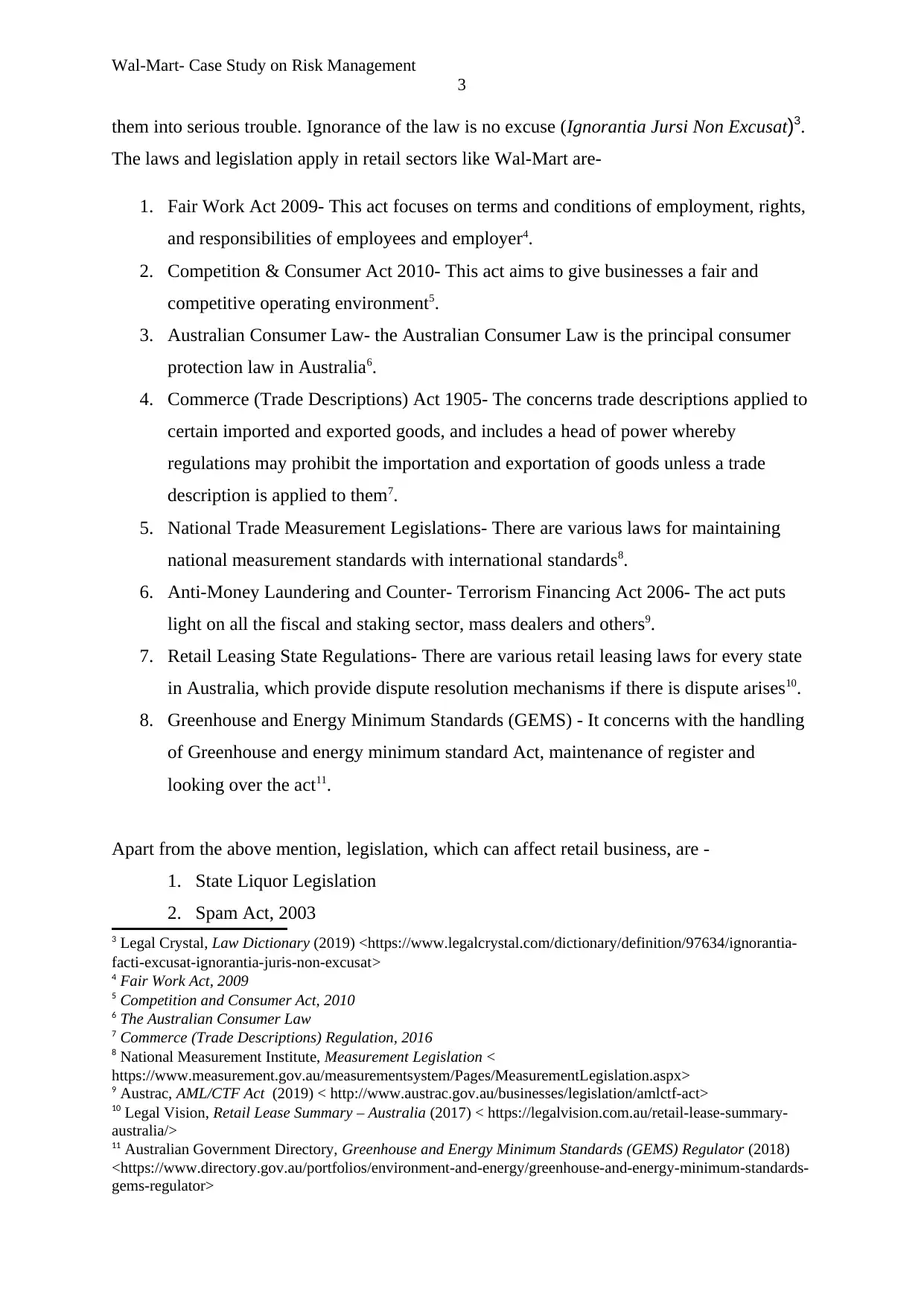
Wal-Mart- Case Study on Risk Management
3
them into serious trouble. Ignorance of the law is no excuse (Ignorantia Jursi Non Excusat)3.
The laws and legislation apply in retail sectors like Wal-Mart are-
1. Fair Work Act 2009- This act focuses on terms and conditions of employment, rights,
and responsibilities of employees and employer4.
2. Competition & Consumer Act 2010- This act aims to give businesses a fair and
competitive operating environment5.
3. Australian Consumer Law- the Australian Consumer Law is the principal consumer
protection law in Australia6.
4. Commerce (Trade Descriptions) Act 1905- The concerns trade descriptions applied to
certain imported and exported goods, and includes a head of power whereby
regulations may prohibit the importation and exportation of goods unless a trade
description is applied to them7.
5. National Trade Measurement Legislations- There are various laws for maintaining
national measurement standards with international standards8.
6. Anti-Money Laundering and Counter- Terrorism Financing Act 2006- The act puts
light on all the fiscal and staking sector, mass dealers and others9.
7. Retail Leasing State Regulations- There are various retail leasing laws for every state
in Australia, which provide dispute resolution mechanisms if there is dispute arises10.
8. Greenhouse and Energy Minimum Standards (GEMS) - It concerns with the handling
of Greenhouse and energy minimum standard Act, maintenance of register and
looking over the act11.
Apart from the above mention, legislation, which can affect retail business, are -
1. State Liquor Legislation
2. Spam Act, 2003
3 Legal Crystal, Law Dictionary (2019) <https://www.legalcrystal.com/dictionary/definition/97634/ignorantia-
facti-excusat-ignorantia-juris-non-excusat>
4 Fair Work Act, 2009
5 Competition and Consumer Act, 2010
6 The Australian Consumer Law
7 Commerce (Trade Descriptions) Regulation, 2016
8 National Measurement Institute, Measurement Legislation <
https://www.measurement.gov.au/measurementsystem/Pages/MeasurementLegislation.aspx>
9 Austrac, AML/CTF Act (2019) < http://www.austrac.gov.au/businesses/legislation/amlctf-act>
10 Legal Vision, Retail Lease Summary – Australia (2017) < https://legalvision.com.au/retail-lease-summary-
australia/>
11 Australian Government Directory, Greenhouse and Energy Minimum Standards (GEMS) Regulator (2018)
<https://www.directory.gov.au/portfolios/environment-and-energy/greenhouse-and-energy-minimum-standards-
gems-regulator>
3
them into serious trouble. Ignorance of the law is no excuse (Ignorantia Jursi Non Excusat)3.
The laws and legislation apply in retail sectors like Wal-Mart are-
1. Fair Work Act 2009- This act focuses on terms and conditions of employment, rights,
and responsibilities of employees and employer4.
2. Competition & Consumer Act 2010- This act aims to give businesses a fair and
competitive operating environment5.
3. Australian Consumer Law- the Australian Consumer Law is the principal consumer
protection law in Australia6.
4. Commerce (Trade Descriptions) Act 1905- The concerns trade descriptions applied to
certain imported and exported goods, and includes a head of power whereby
regulations may prohibit the importation and exportation of goods unless a trade
description is applied to them7.
5. National Trade Measurement Legislations- There are various laws for maintaining
national measurement standards with international standards8.
6. Anti-Money Laundering and Counter- Terrorism Financing Act 2006- The act puts
light on all the fiscal and staking sector, mass dealers and others9.
7. Retail Leasing State Regulations- There are various retail leasing laws for every state
in Australia, which provide dispute resolution mechanisms if there is dispute arises10.
8. Greenhouse and Energy Minimum Standards (GEMS) - It concerns with the handling
of Greenhouse and energy minimum standard Act, maintenance of register and
looking over the act11.
Apart from the above mention, legislation, which can affect retail business, are -
1. State Liquor Legislation
2. Spam Act, 2003
3 Legal Crystal, Law Dictionary (2019) <https://www.legalcrystal.com/dictionary/definition/97634/ignorantia-
facti-excusat-ignorantia-juris-non-excusat>
4 Fair Work Act, 2009
5 Competition and Consumer Act, 2010
6 The Australian Consumer Law
7 Commerce (Trade Descriptions) Regulation, 2016
8 National Measurement Institute, Measurement Legislation <
https://www.measurement.gov.au/measurementsystem/Pages/MeasurementLegislation.aspx>
9 Austrac, AML/CTF Act (2019) < http://www.austrac.gov.au/businesses/legislation/amlctf-act>
10 Legal Vision, Retail Lease Summary – Australia (2017) < https://legalvision.com.au/retail-lease-summary-
australia/>
11 Australian Government Directory, Greenhouse and Energy Minimum Standards (GEMS) Regulator (2018)
<https://www.directory.gov.au/portfolios/environment-and-energy/greenhouse-and-energy-minimum-standards-
gems-regulator>
Paraphrase This Document
Need a fresh take? Get an instant paraphrase of this document with our AI Paraphraser
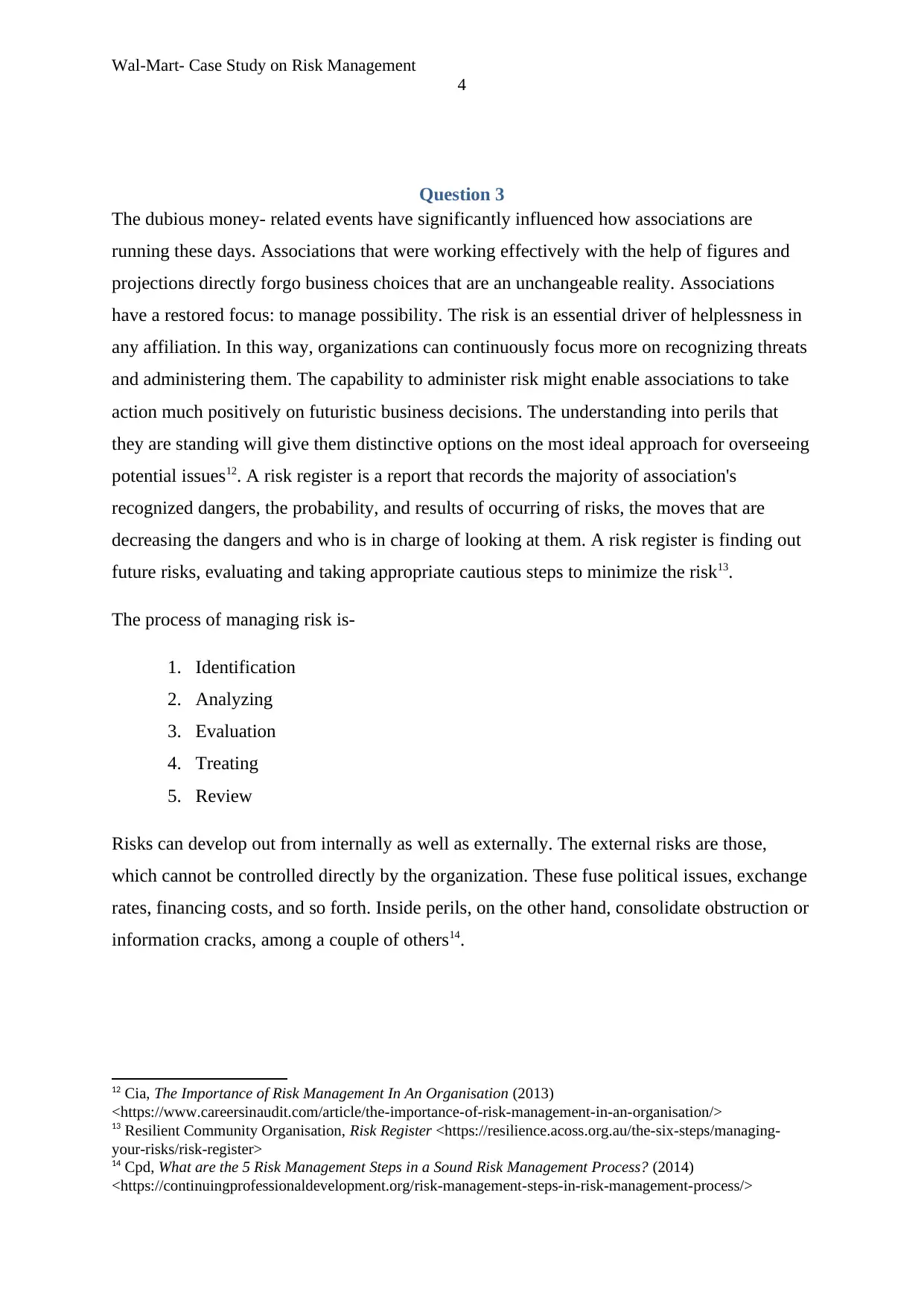
Wal-Mart- Case Study on Risk Management
4
Question 3
The dubious money- related events have significantly influenced how associations are
running these days. Associations that were working effectively with the help of figures and
projections directly forgo business choices that are an unchangeable reality. Associations
have a restored focus: to manage possibility. The risk is an essential driver of helplessness in
any affiliation. In this way, organizations can continuously focus more on recognizing threats
and administering them. The capability to administer risk might enable associations to take
action much positively on futuristic business decisions. The understanding into perils that
they are standing will give them distinctive options on the most ideal approach for overseeing
potential issues12. A risk register is a report that records the majority of association's
recognized dangers, the probability, and results of occurring of risks, the moves that are
decreasing the dangers and who is in charge of looking at them. A risk register is finding out
future risks, evaluating and taking appropriate cautious steps to minimize the risk13.
The process of managing risk is-
1. Identification
2. Analyzing
3. Evaluation
4. Treating
5. Review
Risks can develop out from internally as well as externally. The external risks are those,
which cannot be controlled directly by the organization. These fuse political issues, exchange
rates, financing costs, and so forth. Inside perils, on the other hand, consolidate obstruction or
information cracks, among a couple of others14.
12 Cia, The Importance of Risk Management In An Organisation (2013)
<https://www.careersinaudit.com/article/the-importance-of-risk-management-in-an-organisation/>
13 Resilient Community Organisation, Risk Register <https://resilience.acoss.org.au/the-six-steps/managing-
your-risks/risk-register>
14 Cpd, What are the 5 Risk Management Steps in a Sound Risk Management Process? (2014)
<https://continuingprofessionaldevelopment.org/risk-management-steps-in-risk-management-process/>
4
Question 3
The dubious money- related events have significantly influenced how associations are
running these days. Associations that were working effectively with the help of figures and
projections directly forgo business choices that are an unchangeable reality. Associations
have a restored focus: to manage possibility. The risk is an essential driver of helplessness in
any affiliation. In this way, organizations can continuously focus more on recognizing threats
and administering them. The capability to administer risk might enable associations to take
action much positively on futuristic business decisions. The understanding into perils that
they are standing will give them distinctive options on the most ideal approach for overseeing
potential issues12. A risk register is a report that records the majority of association's
recognized dangers, the probability, and results of occurring of risks, the moves that are
decreasing the dangers and who is in charge of looking at them. A risk register is finding out
future risks, evaluating and taking appropriate cautious steps to minimize the risk13.
The process of managing risk is-
1. Identification
2. Analyzing
3. Evaluation
4. Treating
5. Review
Risks can develop out from internally as well as externally. The external risks are those,
which cannot be controlled directly by the organization. These fuse political issues, exchange
rates, financing costs, and so forth. Inside perils, on the other hand, consolidate obstruction or
information cracks, among a couple of others14.
12 Cia, The Importance of Risk Management In An Organisation (2013)
<https://www.careersinaudit.com/article/the-importance-of-risk-management-in-an-organisation/>
13 Resilient Community Organisation, Risk Register <https://resilience.acoss.org.au/the-six-steps/managing-
your-risks/risk-register>
14 Cpd, What are the 5 Risk Management Steps in a Sound Risk Management Process? (2014)
<https://continuingprofessionaldevelopment.org/risk-management-steps-in-risk-management-process/>
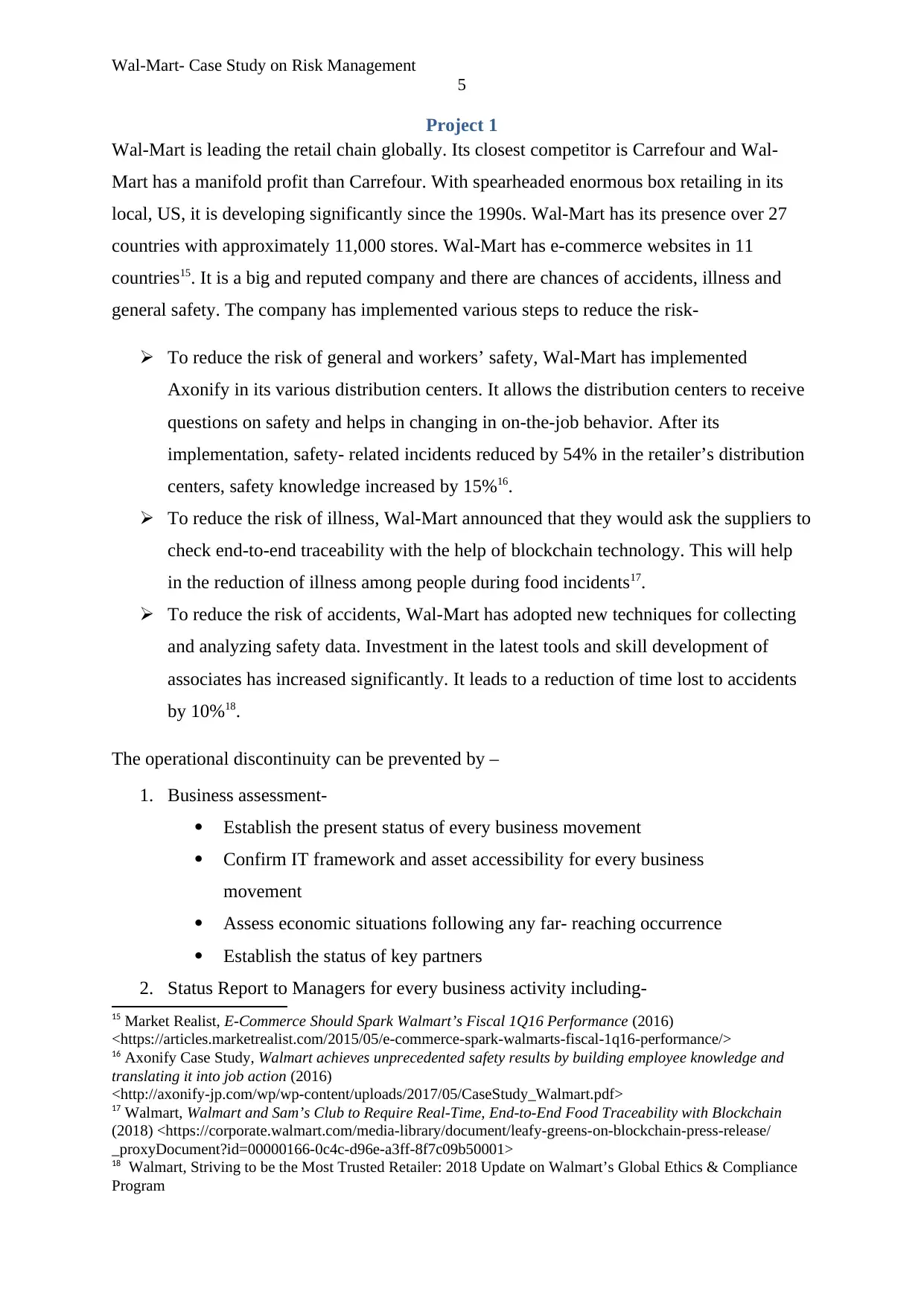
Wal-Mart- Case Study on Risk Management
5
Project 1
Wal-Mart is leading the retail chain globally. Its closest competitor is Carrefour and Wal-
Mart has a manifold profit than Carrefour. With spearheaded enormous box retailing in its
local, US, it is developing significantly since the 1990s. Wal-Mart has its presence over 27
countries with approximately 11,000 stores. Wal-Mart has e-commerce websites in 11
countries15. It is a big and reputed company and there are chances of accidents, illness and
general safety. The company has implemented various steps to reduce the risk-
To reduce the risk of general and workers’ safety, Wal-Mart has implemented
Axonify in its various distribution centers. It allows the distribution centers to receive
questions on safety and helps in changing in on-the-job behavior. After its
implementation, safety- related incidents reduced by 54% in the retailer’s distribution
centers, safety knowledge increased by 15%16.
To reduce the risk of illness, Wal-Mart announced that they would ask the suppliers to
check end-to-end traceability with the help of blockchain technology. This will help
in the reduction of illness among people during food incidents17.
To reduce the risk of accidents, Wal-Mart has adopted new techniques for collecting
and analyzing safety data. Investment in the latest tools and skill development of
associates has increased significantly. It leads to a reduction of time lost to accidents
by 10%18.
The operational discontinuity can be prevented by –
1. Business assessment-
Establish the present status of every business movement
Confirm IT framework and asset accessibility for every business
movement
Assess economic situations following any far- reaching occurrence
Establish the status of key partners
2. Status Report to Managers for every business activity including-
15 Market Realist, E-Commerce Should Spark Walmart’s Fiscal 1Q16 Performance (2016)
<https://articles.marketrealist.com/2015/05/e-commerce-spark-walmarts-fiscal-1q16-performance/>
16 Axonify Case Study, Walmart achieves unprecedented safety results by building employee knowledge and
translating it into job action (2016)
<http://axonify-jp.com/wp/wp-content/uploads/2017/05/CaseStudy_Walmart.pdf>
17 Walmart, Walmart and Sam’s Club to Require Real-Time, End-to-End Food Traceability with Blockchain
(2018) <https://corporate.walmart.com/media-library/document/leafy-greens-on-blockchain-press-release/
_proxyDocument?id=00000166-0c4c-d96e-a3ff-8f7c09b50001>
18 Walmart, Striving to be the Most Trusted Retailer: 2018 Update on Walmart’s Global Ethics & Compliance
Program
5
Project 1
Wal-Mart is leading the retail chain globally. Its closest competitor is Carrefour and Wal-
Mart has a manifold profit than Carrefour. With spearheaded enormous box retailing in its
local, US, it is developing significantly since the 1990s. Wal-Mart has its presence over 27
countries with approximately 11,000 stores. Wal-Mart has e-commerce websites in 11
countries15. It is a big and reputed company and there are chances of accidents, illness and
general safety. The company has implemented various steps to reduce the risk-
To reduce the risk of general and workers’ safety, Wal-Mart has implemented
Axonify in its various distribution centers. It allows the distribution centers to receive
questions on safety and helps in changing in on-the-job behavior. After its
implementation, safety- related incidents reduced by 54% in the retailer’s distribution
centers, safety knowledge increased by 15%16.
To reduce the risk of illness, Wal-Mart announced that they would ask the suppliers to
check end-to-end traceability with the help of blockchain technology. This will help
in the reduction of illness among people during food incidents17.
To reduce the risk of accidents, Wal-Mart has adopted new techniques for collecting
and analyzing safety data. Investment in the latest tools and skill development of
associates has increased significantly. It leads to a reduction of time lost to accidents
by 10%18.
The operational discontinuity can be prevented by –
1. Business assessment-
Establish the present status of every business movement
Confirm IT framework and asset accessibility for every business
movement
Assess economic situations following any far- reaching occurrence
Establish the status of key partners
2. Status Report to Managers for every business activity including-
15 Market Realist, E-Commerce Should Spark Walmart’s Fiscal 1Q16 Performance (2016)
<https://articles.marketrealist.com/2015/05/e-commerce-spark-walmarts-fiscal-1q16-performance/>
16 Axonify Case Study, Walmart achieves unprecedented safety results by building employee knowledge and
translating it into job action (2016)
<http://axonify-jp.com/wp/wp-content/uploads/2017/05/CaseStudy_Walmart.pdf>
17 Walmart, Walmart and Sam’s Club to Require Real-Time, End-to-End Food Traceability with Blockchain
(2018) <https://corporate.walmart.com/media-library/document/leafy-greens-on-blockchain-press-release/
_proxyDocument?id=00000166-0c4c-d96e-a3ff-8f7c09b50001>
18 Walmart, Striving to be the Most Trusted Retailer: 2018 Update on Walmart’s Global Ethics & Compliance
Program
⊘ This is a preview!⊘
Do you want full access?
Subscribe today to unlock all pages.

Trusted by 1+ million students worldwide
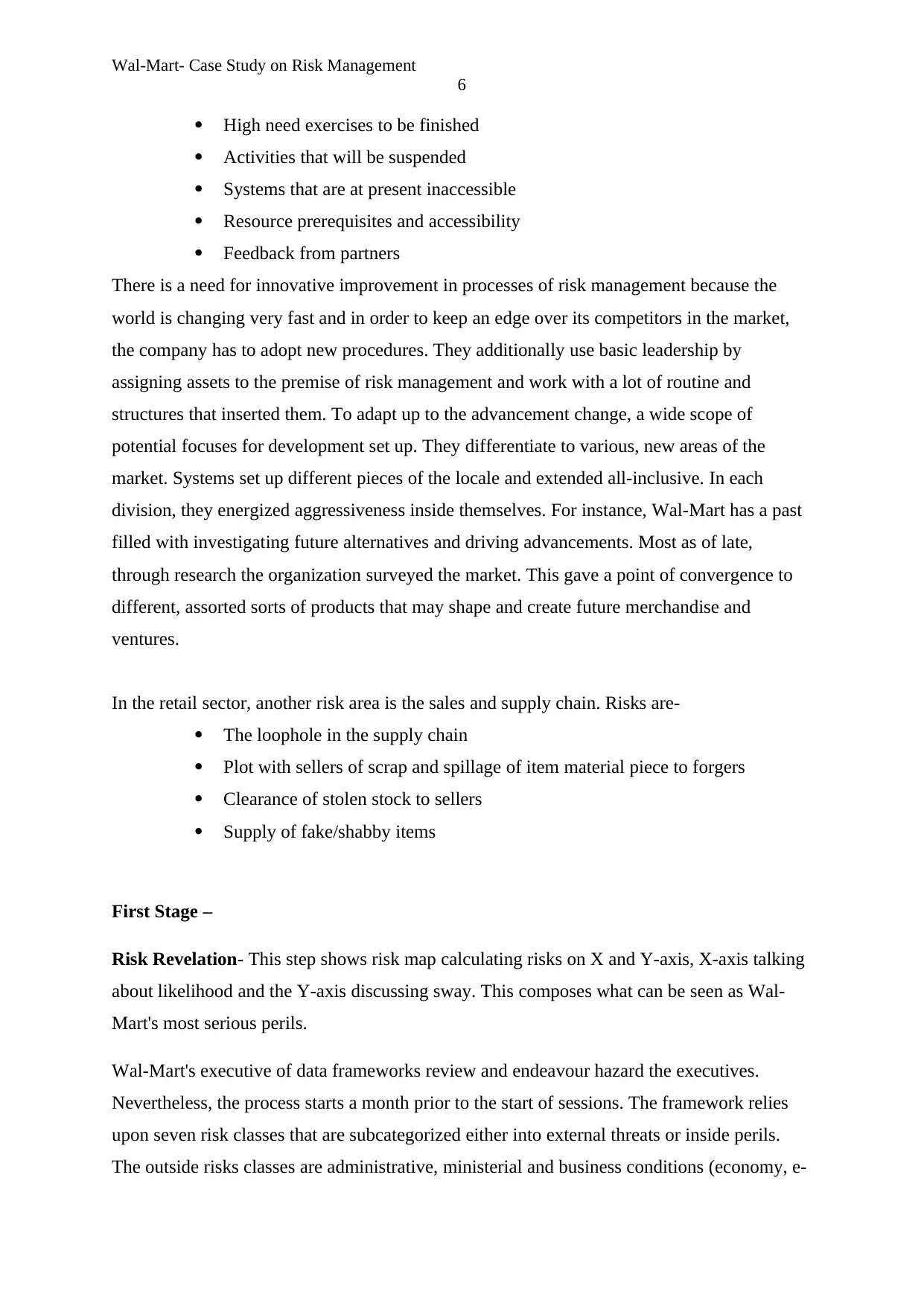
Wal-Mart- Case Study on Risk Management
6
High need exercises to be finished
Activities that will be suspended
Systems that are at present inaccessible
Resource prerequisites and accessibility
Feedback from partners
There is a need for innovative improvement in processes of risk management because the
world is changing very fast and in order to keep an edge over its competitors in the market,
the company has to adopt new procedures. They additionally use basic leadership by
assigning assets to the premise of risk management and work with a lot of routine and
structures that inserted them. To adapt up to the advancement change, a wide scope of
potential focuses for development set up. They differentiate to various, new areas of the
market. Systems set up different pieces of the locale and extended all-inclusive. In each
division, they energized aggressiveness inside themselves. For instance, Wal-Mart has a past
filled with investigating future alternatives and driving advancements. Most as of late,
through research the organization surveyed the market. This gave a point of convergence to
different, assorted sorts of products that may shape and create future merchandise and
ventures.
In the retail sector, another risk area is the sales and supply chain. Risks are-
The loophole in the supply chain
Plot with sellers of scrap and spillage of item material piece to forgers
Clearance of stolen stock to sellers
Supply of fake/shabby items
First Stage –
Risk Revelation- This step shows risk map calculating risks on X and Y-axis, X-axis talking
about likelihood and the Y-axis discussing sway. This composes what can be seen as Wal-
Mart's most serious perils.
Wal-Mart's executive of data frameworks review and endeavour hazard the executives.
Nevertheless, the process starts a month prior to the start of sessions. The framework relies
upon seven risk classes that are subcategorized either into external threats or inside perils.
The outside risks classes are administrative, ministerial and business conditions (economy, e-
6
High need exercises to be finished
Activities that will be suspended
Systems that are at present inaccessible
Resource prerequisites and accessibility
Feedback from partners
There is a need for innovative improvement in processes of risk management because the
world is changing very fast and in order to keep an edge over its competitors in the market,
the company has to adopt new procedures. They additionally use basic leadership by
assigning assets to the premise of risk management and work with a lot of routine and
structures that inserted them. To adapt up to the advancement change, a wide scope of
potential focuses for development set up. They differentiate to various, new areas of the
market. Systems set up different pieces of the locale and extended all-inclusive. In each
division, they energized aggressiveness inside themselves. For instance, Wal-Mart has a past
filled with investigating future alternatives and driving advancements. Most as of late,
through research the organization surveyed the market. This gave a point of convergence to
different, assorted sorts of products that may shape and create future merchandise and
ventures.
In the retail sector, another risk area is the sales and supply chain. Risks are-
The loophole in the supply chain
Plot with sellers of scrap and spillage of item material piece to forgers
Clearance of stolen stock to sellers
Supply of fake/shabby items
First Stage –
Risk Revelation- This step shows risk map calculating risks on X and Y-axis, X-axis talking
about likelihood and the Y-axis discussing sway. This composes what can be seen as Wal-
Mart's most serious perils.
Wal-Mart's executive of data frameworks review and endeavour hazard the executives.
Nevertheless, the process starts a month prior to the start of sessions. The framework relies
upon seven risk classes that are subcategorized either into external threats or inside perils.
The outside risks classes are administrative, ministerial and business conditions (economy, e-
Paraphrase This Document
Need a fresh take? Get an instant paraphrase of this document with our AI Paraphraser
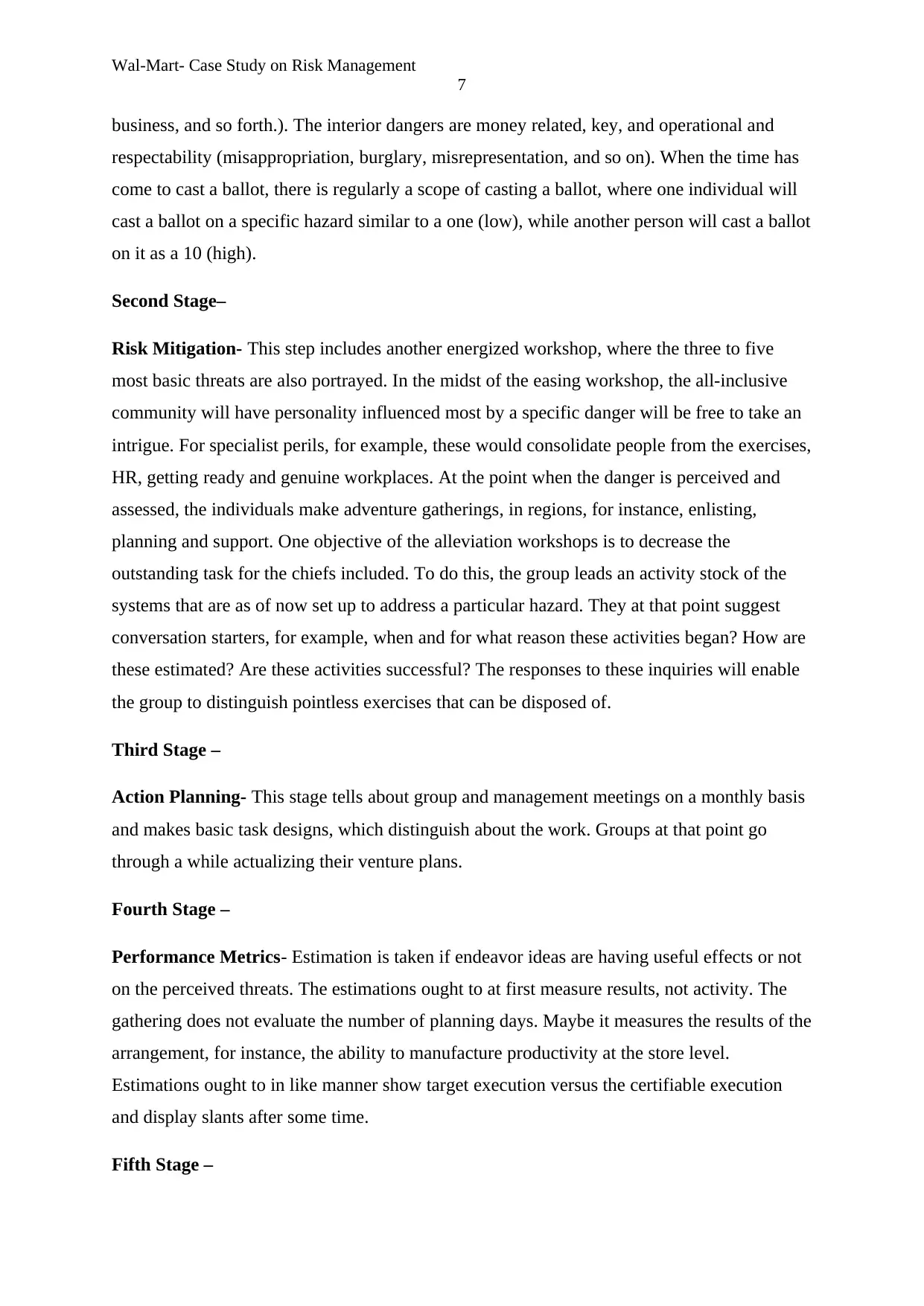
Wal-Mart- Case Study on Risk Management
7
business, and so forth.). The interior dangers are money related, key, and operational and
respectability (misappropriation, burglary, misrepresentation, and so on). When the time has
come to cast a ballot, there is regularly a scope of casting a ballot, where one individual will
cast a ballot on a specific hazard similar to a one (low), while another person will cast a ballot
on it as a 10 (high).
Second Stage–
Risk Mitigation- This step includes another energized workshop, where the three to five
most basic threats are also portrayed. In the midst of the easing workshop, the all-inclusive
community will have personality influenced most by a specific danger will be free to take an
intrigue. For specialist perils, for example, these would consolidate people from the exercises,
HR, getting ready and genuine workplaces. At the point when the danger is perceived and
assessed, the individuals make adventure gatherings, in regions, for instance, enlisting,
planning and support. One objective of the alleviation workshops is to decrease the
outstanding task for the chiefs included. To do this, the group leads an activity stock of the
systems that are as of now set up to address a particular hazard. They at that point suggest
conversation starters, for example, when and for what reason these activities began? How are
these estimated? Are these activities successful? The responses to these inquiries will enable
the group to distinguish pointless exercises that can be disposed of.
Third Stage –
Action Planning- This stage tells about group and management meetings on a monthly basis
and makes basic task designs, which distinguish about the work. Groups at that point go
through a while actualizing their venture plans.
Fourth Stage –
Performance Metrics- Estimation is taken if endeavor ideas are having useful effects or not
on the perceived threats. The estimations ought to at first measure results, not activity. The
gathering does not evaluate the number of planning days. Maybe it measures the results of the
arrangement, for instance, the ability to manufacture productivity at the store level.
Estimations ought to in like manner show target execution versus the certifiable execution
and display slants after some time.
Fifth Stage –
7
business, and so forth.). The interior dangers are money related, key, and operational and
respectability (misappropriation, burglary, misrepresentation, and so on). When the time has
come to cast a ballot, there is regularly a scope of casting a ballot, where one individual will
cast a ballot on a specific hazard similar to a one (low), while another person will cast a ballot
on it as a 10 (high).
Second Stage–
Risk Mitigation- This step includes another energized workshop, where the three to five
most basic threats are also portrayed. In the midst of the easing workshop, the all-inclusive
community will have personality influenced most by a specific danger will be free to take an
intrigue. For specialist perils, for example, these would consolidate people from the exercises,
HR, getting ready and genuine workplaces. At the point when the danger is perceived and
assessed, the individuals make adventure gatherings, in regions, for instance, enlisting,
planning and support. One objective of the alleviation workshops is to decrease the
outstanding task for the chiefs included. To do this, the group leads an activity stock of the
systems that are as of now set up to address a particular hazard. They at that point suggest
conversation starters, for example, when and for what reason these activities began? How are
these estimated? Are these activities successful? The responses to these inquiries will enable
the group to distinguish pointless exercises that can be disposed of.
Third Stage –
Action Planning- This stage tells about group and management meetings on a monthly basis
and makes basic task designs, which distinguish about the work. Groups at that point go
through a while actualizing their venture plans.
Fourth Stage –
Performance Metrics- Estimation is taken if endeavor ideas are having useful effects or not
on the perceived threats. The estimations ought to at first measure results, not activity. The
gathering does not evaluate the number of planning days. Maybe it measures the results of the
arrangement, for instance, the ability to manufacture productivity at the store level.
Estimations ought to in like manner show target execution versus the certifiable execution
and display slants after some time.
Fifth Stage –
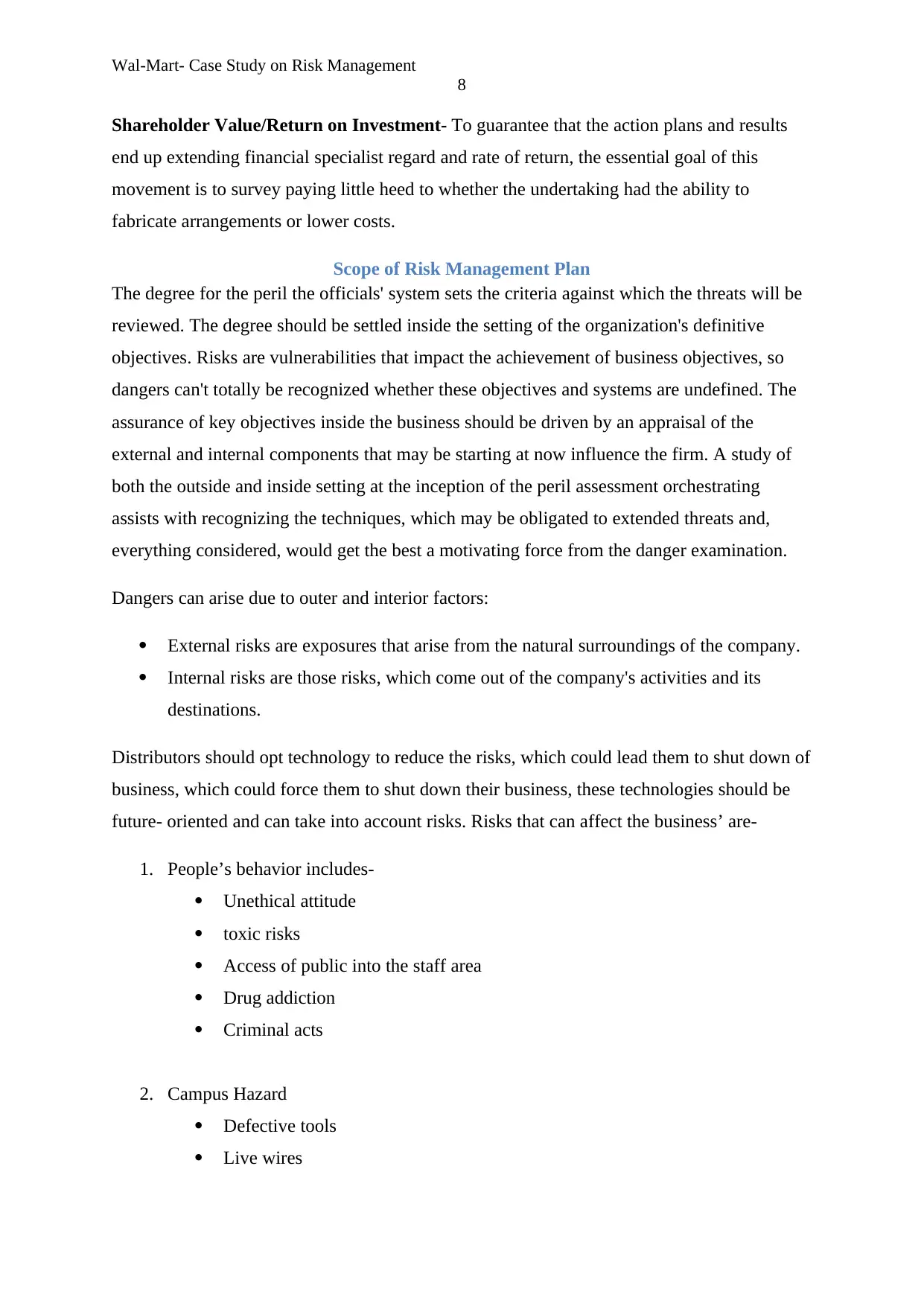
Wal-Mart- Case Study on Risk Management
8
Shareholder Value/Return on Investment- To guarantee that the action plans and results
end up extending financial specialist regard and rate of return, the essential goal of this
movement is to survey paying little heed to whether the undertaking had the ability to
fabricate arrangements or lower costs.
Scope of Risk Management Plan
The degree for the peril the officials' system sets the criteria against which the threats will be
reviewed. The degree should be settled inside the setting of the organization's definitive
objectives. Risks are vulnerabilities that impact the achievement of business objectives, so
dangers can't totally be recognized whether these objectives and systems are undefined. The
assurance of key objectives inside the business should be driven by an appraisal of the
external and internal components that may be starting at now influence the firm. A study of
both the outside and inside setting at the inception of the peril assessment orchestrating
assists with recognizing the techniques, which may be obligated to extended threats and,
everything considered, would get the best a motivating force from the danger examination.
Dangers can arise due to outer and interior factors:
External risks are exposures that arise from the natural surroundings of the company.
Internal risks are those risks, which come out of the company's activities and its
destinations.
Distributors should opt technology to reduce the risks, which could lead them to shut down of
business, which could force them to shut down their business, these technologies should be
future- oriented and can take into account risks. Risks that can affect the business’ are-
1. People’s behavior includes-
Unethical attitude
toxic risks
Access of public into the staff area
Drug addiction
Criminal acts
2. Campus Hazard
Defective tools
Live wires
8
Shareholder Value/Return on Investment- To guarantee that the action plans and results
end up extending financial specialist regard and rate of return, the essential goal of this
movement is to survey paying little heed to whether the undertaking had the ability to
fabricate arrangements or lower costs.
Scope of Risk Management Plan
The degree for the peril the officials' system sets the criteria against which the threats will be
reviewed. The degree should be settled inside the setting of the organization's definitive
objectives. Risks are vulnerabilities that impact the achievement of business objectives, so
dangers can't totally be recognized whether these objectives and systems are undefined. The
assurance of key objectives inside the business should be driven by an appraisal of the
external and internal components that may be starting at now influence the firm. A study of
both the outside and inside setting at the inception of the peril assessment orchestrating
assists with recognizing the techniques, which may be obligated to extended threats and,
everything considered, would get the best a motivating force from the danger examination.
Dangers can arise due to outer and interior factors:
External risks are exposures that arise from the natural surroundings of the company.
Internal risks are those risks, which come out of the company's activities and its
destinations.
Distributors should opt technology to reduce the risks, which could lead them to shut down of
business, which could force them to shut down their business, these technologies should be
future- oriented and can take into account risks. Risks that can affect the business’ are-
1. People’s behavior includes-
Unethical attitude
toxic risks
Access of public into the staff area
Drug addiction
Criminal acts
2. Campus Hazard
Defective tools
Live wires
⊘ This is a preview!⊘
Do you want full access?
Subscribe today to unlock all pages.

Trusted by 1+ million students worldwide
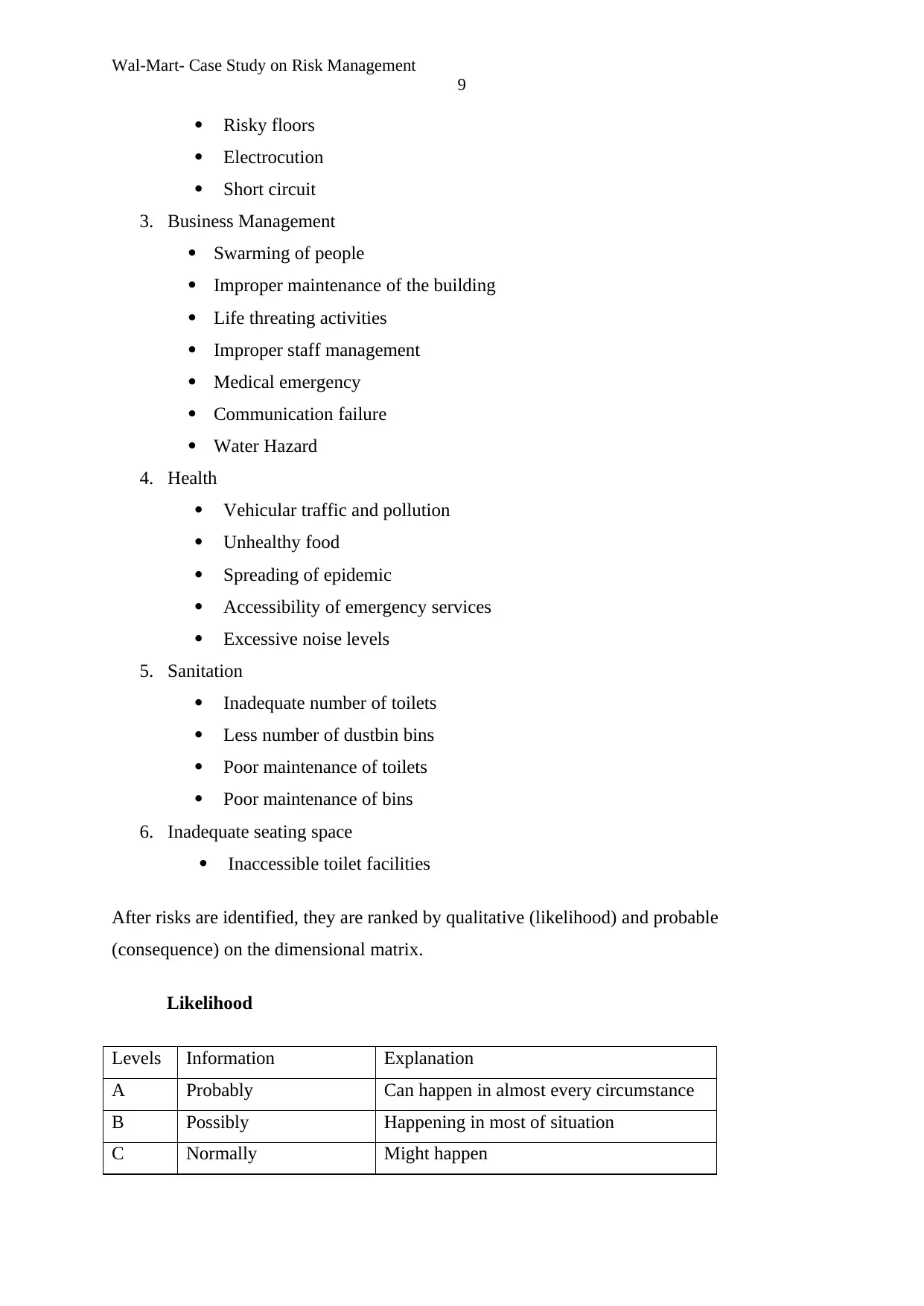
Wal-Mart- Case Study on Risk Management
9
Risky floors
Electrocution
Short circuit
3. Business Management
Swarming of people
Improper maintenance of the building
Life threating activities
Improper staff management
Medical emergency
Communication failure
Water Hazard
4. Health
Vehicular traffic and pollution
Unhealthy food
Spreading of epidemic
Accessibility of emergency services
Excessive noise levels
5. Sanitation
Inadequate number of toilets
Less number of dustbin bins
Poor maintenance of toilets
Poor maintenance of bins
6. Inadequate seating space
Inaccessible toilet facilities
After risks are identified, they are ranked by qualitative (likelihood) and probable
(consequence) on the dimensional matrix.
Likelihood
Levels Information Explanation
A Probably Can happen in almost every circumstance
B Possibly Happening in most of situation
C Normally Might happen
9
Risky floors
Electrocution
Short circuit
3. Business Management
Swarming of people
Improper maintenance of the building
Life threating activities
Improper staff management
Medical emergency
Communication failure
Water Hazard
4. Health
Vehicular traffic and pollution
Unhealthy food
Spreading of epidemic
Accessibility of emergency services
Excessive noise levels
5. Sanitation
Inadequate number of toilets
Less number of dustbin bins
Poor maintenance of toilets
Poor maintenance of bins
6. Inadequate seating space
Inaccessible toilet facilities
After risks are identified, they are ranked by qualitative (likelihood) and probable
(consequence) on the dimensional matrix.
Likelihood
Levels Information Explanation
A Probably Can happen in almost every circumstance
B Possibly Happening in most of situation
C Normally Might happen
Paraphrase This Document
Need a fresh take? Get an instant paraphrase of this document with our AI Paraphraser
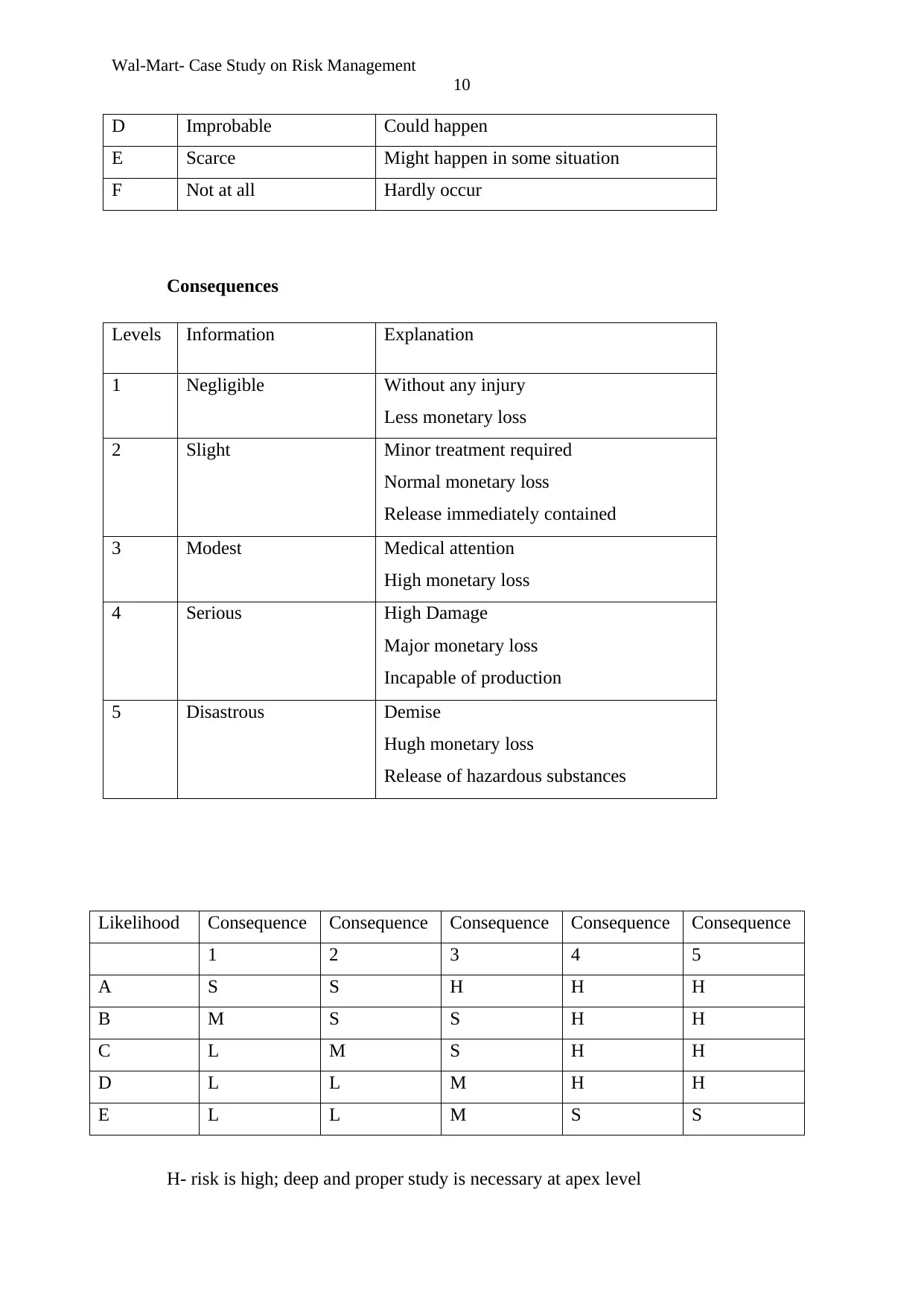
Wal-Mart- Case Study on Risk Management
10
D Improbable Could happen
E Scarce Might happen in some situation
F Not at all Hardly occur
Consequences
Levels Information Explanation
1 Negligible Without any injury
Less monetary loss
2 Slight Minor treatment required
Normal monetary loss
Release immediately contained
3 Modest Medical attention
High monetary loss
4 Serious High Damage
Major monetary loss
Incapable of production
5 Disastrous Demise
Hugh monetary loss
Release of hazardous substances
Likelihood Consequence Consequence Consequence Consequence Consequence
1 2 3 4 5
A S S H H H
B M S S H H
C L M S H H
D L L M H H
E L L M S S
H- risk is high; deep and proper study is necessary at apex level
10
D Improbable Could happen
E Scarce Might happen in some situation
F Not at all Hardly occur
Consequences
Levels Information Explanation
1 Negligible Without any injury
Less monetary loss
2 Slight Minor treatment required
Normal monetary loss
Release immediately contained
3 Modest Medical attention
High monetary loss
4 Serious High Damage
Major monetary loss
Incapable of production
5 Disastrous Demise
Hugh monetary loss
Release of hazardous substances
Likelihood Consequence Consequence Consequence Consequence Consequence
1 2 3 4 5
A S S H H H
B M S S H H
C L M S H H
D L L M H H
E L L M S S
H- risk is high; deep and proper study is necessary at apex level
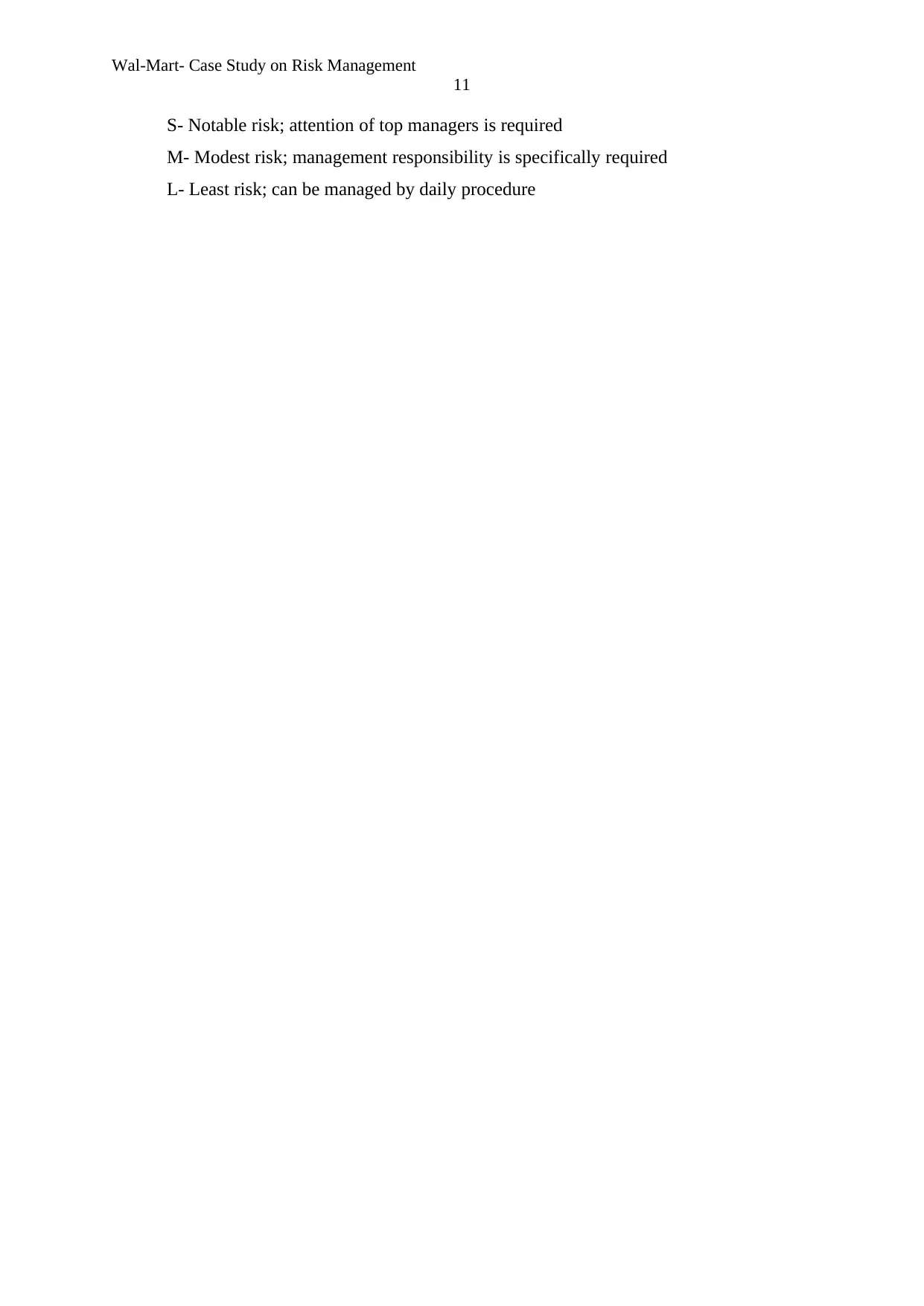
Wal-Mart- Case Study on Risk Management
11
S- Notable risk; attention of top managers is required
M- Modest risk; management responsibility is specifically required
L- Least risk; can be managed by daily procedure
11
S- Notable risk; attention of top managers is required
M- Modest risk; management responsibility is specifically required
L- Least risk; can be managed by daily procedure
⊘ This is a preview!⊘
Do you want full access?
Subscribe today to unlock all pages.

Trusted by 1+ million students worldwide
1 out of 14
Related Documents
Your All-in-One AI-Powered Toolkit for Academic Success.
+13062052269
info@desklib.com
Available 24*7 on WhatsApp / Email
![[object Object]](/_next/static/media/star-bottom.7253800d.svg)
Unlock your academic potential
Copyright © 2020–2025 A2Z Services. All Rights Reserved. Developed and managed by ZUCOL.




